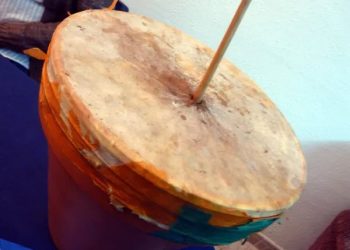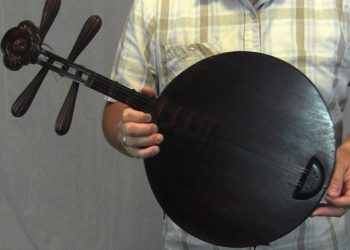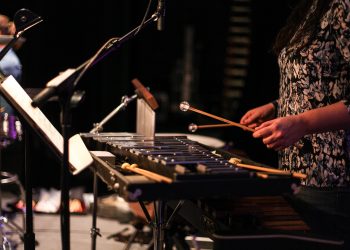Music is a universal language that has been enjoyed by people around the world for centuries. It has the power to move us, inspire us, and bring us together. With a diverse range of instruments available to play, musicians have endless possibilities to express themselves through sound. In this article, we will explore the top 20 musical instruments that start with the letter B.
From brass to percussion, strings to woodwinds, and even electronic instruments, this list covers a wide variety of musical categories. Each instrument has its unique qualities, history, and cultural significance. For instance, the banjo has its roots in African music and is commonly used in genres like bluegrass and country, while the bassoon, a double-reed instrument, is a crucial part of classical orchestras.
Whether you’re an experienced musician or just starting, this list will introduce you to a range of musical instruments that you may not have known existed. Learning about these instruments can broaden your musical knowledge, inspire you to try something new, or simply entertain you with fun and intriguing facts. So, let’s dive into the top 20 musical instruments that start with the letter B and discover the world of music that they offer.
1. Bagpipe
The bagpipe is a unique instrument that has been around for centuries, and it produces some of the most distinct sounds in music. It’s made up of four parts: an air source, usually called a ‘bag’; a chanter, which plays melody notes; drones, which produce continuous harmonious tones; and reeds, which vibrate when the bag is full of air. The sound produced by the bagpipe is unmistakable—it has both low-pitched drones and higher pitched melodies emanating from one single instrument!
To play the bagpipe, you need to fill the bag with air while squeezing it with your arm or hand. You can then use your fingers on the keys along the length of the chanter to create different notes as well as slide them around to create ornamentation. As long as you keep pumping air into the bag you can maintain a steady drone tone while playing intricate melodies over top. This makes it possible to move between tunes quickly without having any pauses or breaks in the flow of music.
A good player will know how to manipulate different techniques such as tonguing, cutting off notes at certain points, and using various gracings (ornamentations) in order to make their performance more interesting and expressive. Additionally, many players will add stylistic touches such as decorations on their pipes or colorful costumes during performances. All these elements come together to give each individual musician their own personal style when playing this traditional instrument.
Bagpipes have historically been used across Scotland, Ireland and other Celtic regions for hundreds of years but they are now played all over the world due to its popularity among folk musicians and those looking for something special for their ensemble pieces. Whether performed solo or within a group setting, there is no denying that this ancient instrument still holds its own place in modern music today!
2. Balafon
The balafon is a percussion instrument that has been played in West African countries for centuries. Its origins can be traced to the Mali Empire, and it’s still used today as an important part of traditional music. While similar to xylophones or marimbas, the balafon stands out due to its unique sound — one characterized by deep bass tones and airy high pitched notes.
Unlike other instruments which require complex fingering techniques, playing the balafon is relatively easy. All you need are two mallets and some basic rhythmic knowledge! The player holds each mallet with their dominant hand and strikes alternating wooden bars on either side of the frame using simple patterns known as ‘calls’. These calls create different rhythms that are accompanied by singing from the performers around them.
The beauty of this particular instrument lies in its versatility – while traditionally used in spiritual ceremonies or storytelling sessions, it also fits into contemporary genres like jazz or funk! Players often add improvisation when performing these styles too, making each performance truly unique and exciting. Furthermore, many modern day orchestras are now featuring balafons alongside more conventional western instruments such as violins or flutes – providing a captivating blend of cultures within their compositions.
In short, there’s no denying that the balafon remains an integral part of both traditional and modern music alike; combining age-old rhythms with newfangled flair to bring alive a remarkable sonic experience every time it’s played!
3. Balalaika
Now, let’s take a look at another traditional instrument – the balalaika. This triangular-shaped Russian stringed instrument is instantly recognizable thanks to its distinct shape and sound. It has been used in folk music for centuries, but it’s also found its way into modern genres like rock or pop!
The balalaika is usually played with three strings tuned to different notes; each one requiring specific fingering techniques. The player plucks or strums these strings rapidly using their fingers, often making use of alternate tunings as well as various rhythms. Additionally, this instrument can be held upright or flat on the lap depending on the type of sound that the musician wishes to produce.
While most people think of the balalaika as just an accompaniment to vocals, many players are now incorporating improvisation into their performances too! These skilled musicians add intricate melodies or extended solos during live shows — creating unique sounds that wouldn’t otherwise be heard from other instruments.
Despite its humble beginnings in Russia’s rural villages, today there are dozens of professional orchestras across Europe who feature balalaikas alongside more classical instruments such as violins or cellos. By combining both Eastern and Western musical styles, they have managed to create truly mesmerizing pieces – further showcasing how versatile this incredible instrument really is!
4. Bandoneon
The bandoneon is another unique instrument from the string family. This square-shaped Argentinian accordion has been used to create a range of musical styles, including tango and folk music. Its sound is often described as melancholic yet passionate — making it the perfect accompaniment for any romantic piece.
Unlike other instruments in this category, which are usually played with two hands, the bandoneon requires just one hand to be operated properly. The musician holds down buttons on either side of the instrument while pushing and pulling bellows to produce different notes. This technique takes time to master but gives players immense control over their performances – allowing them to craft intricate melodies that wouldn’t otherwise be achievable!
Bandoneons have become increasingly popular since they were first introduced into mainstream culture during the 19th century. Many modern bands now use this obscure instrument alongside more traditional ones like guitars or drums; creating an eclectic mix of sounds that can’t help but captivate audiences!
Whether you’re listening to contemporary tangos or old-school folk songs, there’s no denying that the bandoneon adds something special to every performance it’s featured in. From its unique shape and sound all the way through to its versatile playing style, this amazing instrument definitely deserves our attention!
5. Bandura
The bandura is a unique string instrument that originated in Ukraine. It’s been around for centuries, but it has recently gained more popularity due to its captivating sound and interesting playing style. The body of the instrument is shaped like an hourglass with six strings running from one side to the other.
This musical marvel produces a rich and complex tone that can be likened to a combination of guitar and harp sounds. Its versatility allows musicians to express themselves through both fast-paced melodies as well as slower, heartfelt ballads.
Playing the bandura requires skill and practice – you need to know how to use your hands properly on each string while pressing down buttons or plucking them with your fingers. This gives players complete control over their performances, allowing them to create intricate pieces of music without any difficulties!
What’s more, the bandura features prominently in many Ukrainian folk songs — making it an important part of traditional culture and history. Whether it’s used for personal enjoyment or public performance, this magical instrument will always keep audiences enthralled with its enchanting tunes!
6. Banduria
Having explored the bandura, let’s take a closer look at its close relative—the banduria. This instrument has many of the same qualities as the bandura and is also commonly used in Ukrainian folk songs. However, it differs from its counterpart in several key ways.
The first difference lies in its size – while the bandura is relatively large, the banduria is much smaller and more compact. Its hourglass shape remains unchanged, but it only consists of four strings rather than six. The second major distinction between these instruments can be heard when they’re played — due to its fewer strings and lighter soundboard, the notes produced by a banduria are softer and mellower than those of a regular bandura.
This makes them perfect for traditional music styles such as lullabies or slow-paced ballads that require gentler melodies. Furthermore, since they’re so lightweight and portable, they’re ideal instruments for travelling musicians who want to bring their music with them wherever they go!
Additionally, thanks to their distinctive appearance and sound quality, both the bandura and banduria have become symbols of Ukrainian culture around the world. By bringing these unique instruments into our lives through performances or recordings, we can help spread knowledge about this amazing cultural heritage far beyond Ukraine’s borders!
7. Banjo
The next instrument we’ll be looking at is the banjo. While similar in design to its Ukrainian counterparts, it has some distinct differences that set it apart from them. For starters, instead of a round or hourglass body shape like the bandura and banduria have, a banjo typically consists of an open-backed wooden shell with metal strings stretched across it. Additionally, this instrument’s sound is much brighter than those of its Ukrainian relatives—due to the shorter scale length of the neck and frets as well as the placements of its resonator cones which help amplify each note played on the strings.
The unique tone produced by a banjo makes it perfect for playing fast-paced tunes such as bluegrass music and other folk songs. Furthermore, due to their lightweight construction and portability, they are excellent choices for buskers who want to perform outdoors without having to lug around heavy equipment!
Finally, while often associated with American culture and roots music, the banjo actually has deep historic ties to African musical traditions. It is believed that West African slaves brought their own stringed instruments over when they were forcibly moved to North America centuries ago; these early prototypes eventually evolved into what we now know as modern-day banjos. By exploring this fascinating history behind this beloved instrument, we can gain valuable insight into how different cultures interact and influence one another musically!
8. Barbat
The barbat is another instrument that hails from the same general region as the banjo, but it differs in a few key ways. Unlike its cousin, this stringed instrument has an oval-shaped body and utilizes multiple courses of strings—usually four or five tuned differently to achieve various tones. Additionally, rather than using frets like on a banjo, players must use their fingernails to press down on the strings directly while they are being plucked or strummed; this technique requires great dexterity and produces a distinctively mellow sound.
Because of these features, barbats are often used for playing classical Persian music such as dastgah – traditional compositions featuring intricate melodies and rhythms. Furthermore, since it’s smaller size makes it easier to transport compared to other instruments like the sitar or sarod (which also use similar techniques), many performers enjoy taking their barbats with them when traveling around different countries!
Additionally, due to the unique design of this instrument and its associated musical style, some have even argued that its origins stretch back much further into history than those of the banjo–possibly all the way back to ancient Persia during pre-Islamic times. This theory offers fascinating insight into how certain instruments can be traced through multiple cultures over time.
Today, regardless of where one may find themselves geographically speaking, there will no doubt be someone nearby who enjoys playing the barbat and keeping alive this important tradition!
9. Baryton
Moving on from the barbat, another stringed instrument worthy of mention is the baryton. While this instrument may not be as well-known as its predecessor, it has been around since at least the 16th century and enjoys a unique place in musical history. Unlike most other instruments, which have either four or six strings, the baryton utilizes upwards of three dozen different strings; these are divided into several distinct courses that can produce various tones depending on how they are tuned.
The particular tuning method used for the baryton requires great skill from the musician; firstly, each course must be properly adjusted so that specific notes will come out clearly when plucked by hand or with a bow. Secondly, each note must also then be carefully measured using special devices called “capos” (essentially metal bars placed over some of the strings). This intricate process results in an incredibly full sound that cannot be achieved with any other kind of instrument!
Because of its dramatic soundscape and technical difficulty level, classical composers such as Haydn and Mozart often wrote pieces specifically to be played on this instrument—many of which still remain popular today. Despite being traditionally associated with European music culture however, there are many examples throughout recent years where musicians have blended together elements from various genres to create something truly unique–including jazz renditions of classic rock songs!
In short, whether you’re looking for traditional compositions or more modern takes on beloved tunes, playing the baryton can provide hours upon hours of entertainment for both listeners and performers alike.
10. Bass Clarinet
The bass clarinet is a unique and multifaceted instrument that has been used in many genres of music. With its deep, resonant tone, the bass clarinet can add a powerful layer to any ensemble. It is typically pitched one octave below the standard B♭ clarinet; however, some versions are also available with an extended range into the lower register.
Unlike other woodwind instruments which use reeds for sound production, the bass clarinet uses two single-reed mouthpieces: one for playing low notes and another for high notes. This allows for greater flexibility when crafting solos or accompaniment parts. Furthermore, thanks to its larger size, it’s possible to produce more volume than smaller wind instruments—making it ideal for those who want their musical presence heard!
While most people think of classical compositions when they hear the words “bass clarinet” this versatile instrument has found homes in jazz and even rock bands throughout recent years. Whether you’re looking to bring out intricate melodies or thunderous riffs, this instrument can provide both singers and instrumentalists alike with endless opportunities to explore new sonic landscapes. As such, there’s no better time than now to learn how to play this underrated yet incredibly dynamic tool!
From composers like Mozart all the way up through modern day musicians experimenting with various sounds, the bass clarinet remains an indispensable part of musical history. Its versatility makes it perfect not only as a solo instrument but also in ensembles ranging from small duets to entire orchestras—and everything in between! So if you’re ready to take your music making skills up a notch then grab yourself a bass clarinet and get started on your journey toward mastering this remarkable instrument today!
11. Bass Drum
The bass drum is a large percussion instrument that has been used for centuries to add depth and power to musical compositions. It’s commonly found in marching bands, orchestras, jazz ensembles, rock bands, and even hip-hop groups. This essential piece of equipment produces a low thumping sound which provides the underlying beat or pulse for any given song. Additionally, its size makes it capable of producing huge amounts of volume—making it perfect for providing rhythm during live performances.
Playing the bass drum can be quite challenging; however, with some practice and dedication you’ll soon find yourself grooving along with ease! There are several techniques used when striking the drum such as using brushes and sticks, rolling patterns on the head of the drum, double strokes with alternating feet, and other more advanced methods like paradiddle rudiments. Of course, mastering all these different approaches will take time but once you’ve got them down pat then you’ll have an extensive range of possibilities at your fingertips!
For those looking to incorporate this iconic instrument into their own music productions there are plenty of software options available that allow users to simulate realistic sounding bass drums without having access to one in real life. These programs come preloaded with hundreds of samples from classic acoustic kits or modern electronic ones so no matter what genre you’re working within there should be something suitable available.
No matter how you decide to use it, the bass drum can bring new levels of energy and vibrancy to any composition. Whether you choose to go traditional by playing one or opt for virtual versions instead – either way it’s sure to leave audiences enthralled! So why not start exploring today? Who knows where your creativity might lead you!
12. Bass Guitar
The bass guitar is another essential instrument in many types of music. Its low-end tones provide the foundation and groove for songs, allowing them to stand out from other instruments in a mix. From jazz standards to heavy metal, this versatile instrument can be found across genres and has been around for centuries.
Playing the bass requires an understanding of how notes interact with each other as well as being able to play basic scales, chords and arpeggios. Many aspiring players start off by learning simple melodies on electric or acoustic guitars before transitioning to bass. This approach helps build up the necessary skills needed for playing the instrument effectively. Additionally, those looking to further their abilities can take lessons from experienced teachers who will teach them more advanced techniques such as slapping, popping, tapping and fingerstyle playing.
In modern music production it’s possible to use virtual versions of bass guitars which offer users access to thousands of samples that allow them to achieve realistic sounding results without having access to real instruments. Furthermore, there are several software programs available that make creating complex parts much easier than ever before – making producing professional sounding tracks within reach even for beginner producers!
From its groovy soundscapes in funk tracks to its pulsing backbeats in pop hits – the potential of what can be done with a bass guitar is seemingly endless! So why not pick one up today? You never know where your musical journey may lead you!
13. Bass Oboe
The bass oboe is a lesser-known member of the woodwind family, but it has its own unique sound and can add an interesting layer to various musical styles. While not as commonly used as other instruments such as the clarinet or saxophone, it still plays an important role in orchestras and bands. It’s usually played by experienced musicians due to its difficult range and fingerings.
The bass oboe features a conical bore with double reeds that give it a deep, mellow tone similar to a baritone saxophone. Its size also allows for more dynamic control than smaller wind instruments like flutes or piccolos. The length of time required to learn how to play it means most students will start out on another instrument first before attempting this one – although some have managed to master both at once!
It’s possible to use different techniques when playing the bass oboe depending on what type of music you’re trying to create. For instance, using vibrato creates a warm, expressive sound while articulation helps bring out individual notes which can be used in jazz solos or classical pieces respectively. Additionally, players can experiment with extended ranges and alternate fingerings if they wish to explore further possibilities.
Having the ability to produce unique sounds makes the bass oboe an ideal choice for those who want to try something new or challenge themselves musically. Whether you’re looking for a way into symphonic arrangements or just want some extra low-end support in your band – there’s no denying that this interesting instrument has plenty offer!
14. Basset-Horn
The basset-horn is a lesser known wind instrument, but it’s quickly becoming popular amongst musicians due to its unique tone. It’s even been featured in some of the most iconic films and TV shows like Jurassic Park, Harry Potter and Game of Thrones! This woodwind has an attractive curved shape with double reeds that give it a warm sound similar to an alto saxophone or clarinet.
A relatively easy instrument to learn for beginners, the basset-horn features few keys and fingerings which makes it suitable for players who want to progress quickly. Those with more experience can also experiment with extended ranges and alternate fingerings as they become more comfortable playing this versatile instrument. As well as having a mellow yet powerful sound, the basset-horn is capable of producing subtleties such as vibrato, staccato notes and dynamic control – making it perfect for jazz solos or classical pieces alike.
For those looking for something out of the ordinary, the basset-horn may be just what you need. Its distinct timbre allows you to add texture and depth to any performance – whether you’re playing solo or accompanying others. Not only does this instrument have great versatility when it comes to musical styles, but also an impressive range that can allow you stand out from other instruments in your ensemble.
All things considered, this amazing member of the woodwind family offers plenty of possibilities for both novice players and experienced musicians alike. So why not take up the challenge today and explore all that this fascinating instrument has to offer?
15. Bassoon
Having discussed the basset-horn, we can now turn our attention to its larger cousin – the bassoon. This double reed instrument has been a staple of orchestra and chamber music since the Baroque period, thanks to its rich and powerful sound. It’s also gained recognition in recent years due to its versatility – allowing it to be used for everything from jazz solos to classical compositions.
Unlike many other wind instruments, the bassoon is not particularly easy for beginners due to its complex fingerings and range. However with some perseverance, players can quickly become accustomed to this fascinating instrument. As well as being capable of producing bright tones that can cut through an ensemble easily, the bassoon also offers more subtle nuances such as vibrato and dynamic control which experienced musicians may find appealing.
Not only does this woodwind provide excellent tonal coloration when playing solo or accompanying others, but its size allows it to fit into tight spaces during performances – making it perfect for those who are short on space! And if you’re looking for something unique then consider picking up a contrabassoon – providing even deeper notes than their standard counterpart which creates a truly captivating effect in any musical setting.
The possibilities provided by the bassoon are almost endless; so why not explore what this amazing instrument has to offer? With practice and dedication you could soon be mastering one of history’s most iconic instruments!
16. Bazooka
The bazooka is a musical instrument that has been around for centuries. It’s a type of horn, usually made from brass or other metals like aluminum and nickel. A bell is connected to the end of the tube so that when air is blown into it, sound can be produced. The player holds the mouthpiece in their mouth and blows through it with their lips closed. As they blow harder, higher notes are created.
The bazooka was originally used as an accompaniment instrument in marching bands and military ceremonies, but these days it’s often found in jazz ensembles or solo performance pieces. Its unique shape allows for both low and high tones to be heard at once; this gives it a full range of sound. Additionally, its portability makes it easy to transport anywhere you may need some music – perfect for those spontaneous jam sessions!
One thing that sets the bazooka apart from other instruments is its wide dynamic range: players can easily switch between quiet and loud playing depending on what kind of atmosphere they’re trying to create. This versatility makes it great not only for traditional performances but also modern electronica-inspired pieces as well. Finally, due to its size, many people find the bazooka easier to learn than larger horns like trumpets or trombones – making it an ideal choice for beginners who want to start exploring different sounds quickly.
No matter your skill level or style preferences, the bazooka is sure to provide an interesting sonic experience – whether you’re looking for a gentle background melody or something more intense!
17. Bells
With their vibrant sound and unique shape, bells are an iconic instrument with a long history. Unlike the bazooka, they don’t require any blowing or other physical effort to produce music – instead, all you need is your hand! Bells come in many sizes and shapes, so there’s bound to be one for everyone’s taste. Even better, since they don’t have any moving parts, they’re incredibly easy to take care of; just wipe them down every once in a while and you’ll be good to go.
Another great thing about bells is that they can be used both as accompaniment instruments and solo pieces. Whether you’re looking for something gentle and melodic or loud and powerful, bells offer a surprising range of sounds that will definitely add some spice to your performance. Plus, their unique resonance allows players to create lush chords with ease – perfect for those who want to mix up their repertoire without having too much trouble!
As if these weren’t enough reasons already, playing bells also provides another perk: it can help build coordination skills over time. When musicians practice ringing different bell patterns together at different speeds, they learn how to work together with others more effectively – which is always useful when creating collaborative works of art. Additionally, this type of exercise helps improve eye-hand coordination; after all, cleaning up mistakes quickly requires quite a bit of dexterity!
In short, no matter what kind of music you make or why you play it – incorporating bells into your compositions can bring lots of benefits both musically and physically. With its wide variety of tones and textures available from such a simple device – it’s no wonder why this instrument has been around for centuries!
18. Bell Tree
The bell tree is a type of instrument that’s closely related to the bells mentioned above. However, it differs in one key aspect: instead of being rung by hand, the bell tree has multiple metal tubes arranged vertically on a frame and struck with mallets. The result is an incredibly unique sound – both mellow and vibrant at once! This makes it perfect for adding some extra texture or atmosphere to any musical piece.
But what really sets the bell tree apart from other instruments are its portability and versatility. With only a few parts making up this instrument, you can easily disassemble it when needed; plus, due to its low weight, carrying it around won’t be much trouble either. On top of that, because each tube is tuned differently, musicians have plenty of options when it comes to creating different tones. Whether they’re looking for something soft and delicate or loud and powerful – there’s bound to be something that fits their needs perfectly!
Another great thing about bell trees is how easy they are to learn – even beginners can pick them up quickly thanks to their simple nature. Plus, since practice isn’t necessarily required (unlike more complicated instruments), players don’t need too much time before they start experimenting with all sorts of sounds. And if they want some help along the way? There’s no shortage of tutorials available online so anyone can get started right away!
In short, whether you’re just starting out or already experienced in music-making – having a bell tree within your arsenal will definitely come in handy sooner or later. It provides endless possibilities for those who wish to explore new sonic territories without sacrificing portability or ease-of-use – so why not give it a try?
19. Berimbau
The berimbau is a fascinating instrument that has been used in Brazilian culture for centuries. It consists of an arched wooden bow, called the verga, which is strung with one metal string and attached to a cabaça (gourd) resonator filled with seeds or gravel. This gives it its distinct sound – deep and mellow yet ever-so-slightly metallic.
Not only does this make the berimbau great for creating music but also as part of performances. The player holds the instrument against their body while playing it with a stick – usually accompanied by other instruments such as drums and shakers – resulting in some truly mesmerizing sounds! Plus, since its size allows for easy transportation, you can take your performance anywhere – from small clubs to large festivals.
But what makes the berimbau even more special is how versatile it can be. For example, each type of the instrument produces different tones; plus, you can adjust not just the pitch but also volume depending on how hard you strike the strings. And if that wasn’t enough? The way players move around when performing adds even more dynamics to the mix – making sure no two performances are alike!
For all these reasons, learning how to play this captivating instrument should definitely be high on any musician’s list. With its unique sounds and vibrant energy, there’s plenty of potential here waiting to be explored – so why wait? Get yourself a berimbau today and start discovering all its wonders!
20. Bongo
The bongo is another fascinating musical instrument that has been used in many different cultures for hundreds of years. It consists of two small, single-headed drums attached to each other – the larger one known as hembra (feminine) and the smaller one macho (masculine). What makes it so special is its versatility; you can play a wide range of rhythms depending on how hard or soft you hit the drums. Plus, since both heads are open, they create an interesting resonance effect which gives your music even more depth!
One great thing about playing the bongos is that it’s relatively easy to learn compared to some other instruments – all you need to do is get comfortable with controlling your grip and timing. However, mastering this instrument takes time and patience; practice regularly and soon enough you’ll be able to craft intricate rhythms from just a few beats. And once you feel confident enough? You can start experimenting with different techniques like double strokes and rimshots – adding yet another layer of complexity to your sound!
And let’s not forget how versatile these drums can be when it comes to genres; whether it’s jazz, reggae or Latin American styles such as salsa, there’s something here for everyone. Plus, by using different sticks and adjusting their size/weight as well as drumhead tension levels, you can shape your tone however you want – making sure no two performances will ever be alike!
So if you’re looking for an accessible yet powerful way to add rhythm into your music? Look no further than the bongo – no matter what style or genre of music appeals to you most. With its fun sound and endless possibilities, now’s the perfect time to take up this captivating instrument!










